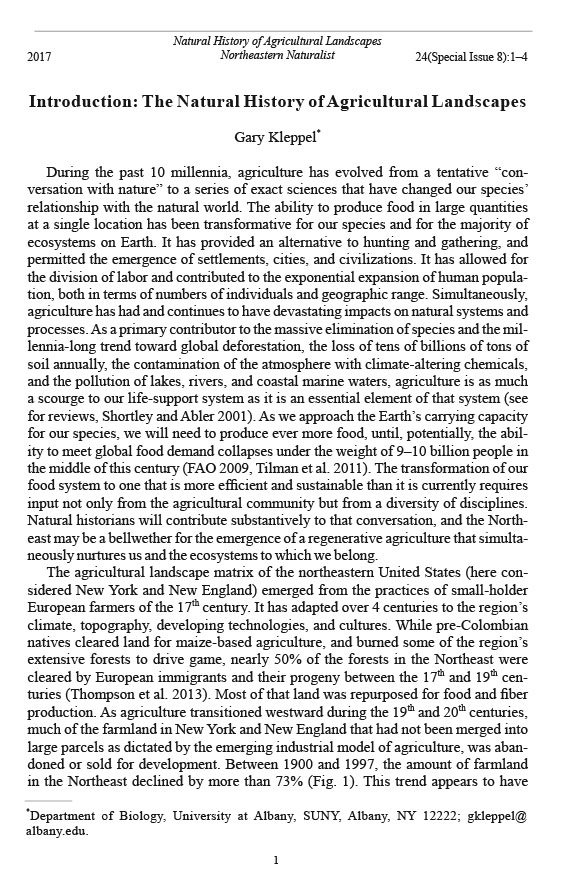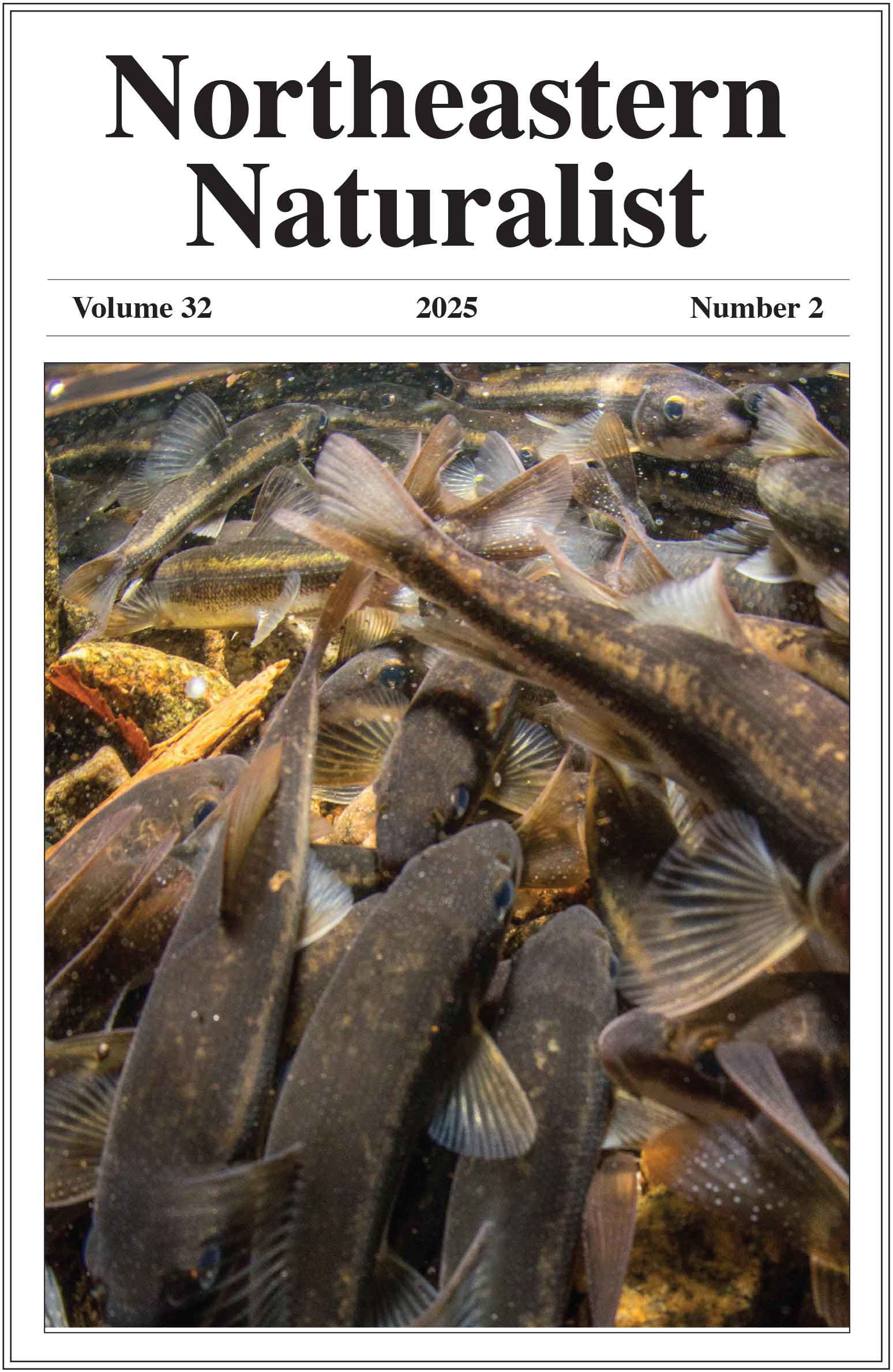Northeastern Naturalist
1
G. Kleppel
2017 Vol. 24, Special Issue 8
Introduction: The Natural History of Agricultural Landscapes
Gary Kleppel*
During the past 10 millennia, agriculture has evolved from a tentative “conversation
with nature” to a series of exact sciences that have changed our species’
relationship with the natural world. The ability to produce food in large quantities
at a single location has been transformative for our species and for the majority of
ecosystems on Earth. It has provided an alternative to hunting and gathering, and
permitted the emergence of settlements, cities, and civilizations. It has allowed for
the division of labor and contributed to the exponential expansion of human population,
both in terms of numbers of individuals and geographic range. Simultaneously,
agriculture has had and continues to have devastating impacts on natural systems and
processes. As a primary contributor to the massive elimination of species and the millennia-
long trend toward global deforestation, the loss of tens of billions of tons of
soil annually, the contamination of the atmosphere with climate-altering chemicals,
and the pollution of lakes, rivers, and coastal marine waters, agriculture is as much
a scourge to our life-support system as it is an essential element of that system (see
for reviews, Shortley and Abler 2001). As we approach the Earth’s carrying capacity
for our species, we will need to produce ever more food, until, potentially, the ability
to meet global food demand collapses under the weight of 9–10 billion people in
the middle of this century (FAO 2009, Tilman et al. 2011). The transformation of our
food system to one that is more efficient and sustainable than it is currently requires
input not only from the agricultural community but from a diversity of disciplines.
Natural historians will contribute substantively to that conversation, and the Northeast
may be a bellwether for the emergence of a regenerative agriculture that simultaneously
nurtures us and the ecosystems to which we belong.
The agricultural landscape matrix of the northeastern United States (here considered
New York and New England) emerged from the practices of small-holder
European farmers of the 17th century. It has adapted over 4 centuries to the region’s
climate, topography, developing technologies, and cultures. While pre-Colombian
natives cleared land for maize-based agriculture, and burned some of the region’s
extensive forests to drive game, nearly 50% of the forests in the Northeast were
cleared by European immigrants and their progeny between the 17th and 19th centuries
(Thompson et al. 2013). Most of that land was repurposed for food and fiber
production. As agriculture transitioned westward during the 19th and 20th centuries,
much of the farmland in New York and New England that had not been merged into
large parcels as dictated by the emerging industrial model of agriculture, was abandoned
or sold for development. Between 1900 and 1997, the amount of farmland
in the Northeast declined by more than 73% (Fig. 1). This trend appears to have
*Department of Biology, University at Albany, SUNY, Albany, NY 12222; gkleppel@
albany.edu.
Natural History of Agricultural Landscapes
2017 Northeastern Naturalist 24(Special Issue 8):1–4
Northeastern Naturalist
G. Kleppel
2017
2
Vol. 24, Special Issue 8
bottomed out at the turn of the 21st century. It is evident that small-scale farming is
now in recovery, not only in the Northeast but in many parts of the world (Van der
Ploeg 2008).
The historic tension between conservation and agriculture is widely recognized
(Carr and Tate 1991). In the Northeast, where environmental values are strongly
held, small-holder farming is equally valued. With more than 20 billion dollars in
annual fiscal impact, agriculture is a regional economic engine. Consumer interests,
evidenced by the locavore movement, the explosive growth of farmers markets and
community supported agriculture (Kleppel 2014), and the apparent need for a strong
agricultural response to increasing food demand (Cripp 2010) suggest that popular
support of agriculture in New York and New England will continue and increase in
the future (Lyson and Guptil 2004). This should not, however, be seen as an abandonment
of the conservation ethic. The small- to medium-scale approach to farming that
characterizes much of the region’s agriculture and a regionally strong interest among
farmers and consumers in sustainable methods of food production suggest that conservation
and agriculture can (and, indeed, must) co-exist (Batie 2003).
Aldo Leopold (1947:240), the recognized father of conservation biology and
himself a subsistence farmer, advised that we abandon the idea of “… Homo sapiens
as conqueror of the land community”, and accept our responsibilities as “…
plain member and citizen of it”. As citizens of the land community, we have a right
to acquire food. The charge of Leopold, however, is that we must be responsible as
farmers. Data from literally hundreds of studies suggest that agriculture can be regenerative
and sustainable, that farms can sequester carbon, store water, immobilize
Figure 1. Farmland loss in New
York and New England from 1900
to 2012. Source of data: NASS
2012.
Northeastern Naturalist
3
G. Kleppel
2017 Vol. 24, Special Issue 8
nutrients, enhance biodiversity, create soil, and reduce erosion, all while producing
food and fiber for a burgeoning human population (e.g, Pearson 2007, Rodale 1983,
Sherwood and Uphoff 2000). Conservationists and farmers can no longer afford
to be antagonists. We are already cooperating and must increase the extent of our
collaboration. Natural historians have a key role to play in creating that necessary
dialogue and moving it forward.
This special issue of Northeastern Naturalist on the Natural History of
Agricultural Landscapes is a contribution to that dialogue. It emerged as a result
of a well-attended session on the topic convened at the Northeast Natural History
Conference in Springfield, MA, in April 2015. The issue begins with an examination
by Abercrombie et al. of the extent to which seasonally migratory seed predators
subsidize weed seed removal from croplands. Next, Smiley et al. use a multivariate
approach to resolve the roles that instream and watershed factors play in determining
Creek Chub population dynamics in Ohio streams that run through agricultural
lands. Beattie et al. follow with an evaluation of the use of “targeted grazing” with
sheep to restore critically imperiled grassland habitat on Nantucket Island, MA.
Continuing with a consideration of the roles of livestock on agricultural ecosystems,
Girard Cartier and Kleppel examine the ways that different grazing strategies
influence the coupling of soil microbial and plant communities, and Cassidy and
Kleppel address the problem of the coexistence of livestock (cattle) and grassland
breeding birds on pastures in New York’s Hudson and Mohawk River Valleys. The
issue concludes with a description by Sutti et al. of the development of a decisionmaking
tool to support grassland breeding bird habitat conservation in agricultural
landscapes. We realize that while highlighting some of the myriad ways natural
history research is and could be informing and improving our farming practices and
approach to managing agricultural lands, this collection barely scratches the surface
on this topic. However, we hope the papers in this issue will stimulate interest in
the ecology and natural history of the agricultural landscapes of the Northeast and
that further research and intercommunity communication will follow as a result.
Literature Cited
Abercrombie, S.A., J.L. Berl, E.A. Flaherty, and R.K. Swihartn. 2017. Seasonal foraging by
forest mice enhances loss of weed seeds from crop–field edges. Northeastern Naturalist
24(Special Issue 8):5–17.
Batie, S.S. 2003. The multifunctional attributes of northeastern agriculture: A research
agenda. Agricultural and Resource Economics Review 32:1–5.
Beattie, K.C., J.M. Karberg, K.A. Omand, and D.I. O’Dell. 2017. Sheep grazing as a grassland
management tool: Lessons learned on Nantucket Island, Massachusetts. Northeastern
Naturalist 24(Special Issue 8):45–66.
Carr, S., and J. Tate. 1991. Differences in the attitudes of farmers and conservationists and
their implications. Journal of Environmental Management 32:281–294.
Cassidy, L.R., and G.S. Kleppel. 2017. The effect of grazing regime on grassland bird abundance
in New York State. Northeastern Naturalist 24(Special Issue 8):86–98.
Cripp, J. 2010. The Coming Famine. University of California Press, Berkeley, CA.
Northeastern Naturalist
G. Kleppel
2017
4
Vol. 24, Special Issue 8
Food and Agriculture Organization (FAO). 2009. The state of food insecurity in the world.
Economic crisis: Impacts and lessons learned. United Nations, R ome, Italy.
Girard-Cartier, C.B., and G.S. Kleppel. 2017. Grazing and the coupling of biodiversity in
vascular plant and soil microbial communities. Northeastern Naturalist 24(Special Issue
8):67–85.
Kleppel 2014. The Emergent Agriculture. New Society Publishers, Gabriola Island, BC,
Canada.
Leopold, A. 1947. A Sand County Almanac. Reprinted by Island Press, Washington, DC.
Lyson, T.A. and A. Guptil 2004. Commodity agriculture, civic agriculture, and the future
of US ffarming. Rural Sociology 69:370–385.
National Agricultural Statistics Service, US Department of Agriculture (NASS). 2012.
Census of Agriculture. Available online at https://www.agcensus.usda.gov/Publications/
2012/. 16 August 2017.
Pearson, C.J. 2007. Regenerative, semiclosed systems: A priority for twenty-first-century
Agriculture. BioScience 57:409–418.
Rodale, R. 1983. Breaking new ground: The search for a sustainable agriculture. The Futurist
17: 15–20.
Sherwood, S., and N. Uphoff. 2000. Soil health: Research, practice, and policy for a more
regenerative agriculture. Applied Soil Ecology 15:84–97.
Shortley, J.S., and D.G. Abler (Eds.). 2001.Environmental Policies for Agricultural Pollution
Control. CABI Publishing, New York, NY.
Smiley, P.C., Jr., Kevin W. King, and Norman R. Fausey. 2017. Influence of different habitat
factors on Creek Chub (Semotilus atromaculatus) within channelized agricultural headwater
streams. Northeastern Naturalist 24(Special Issue 8):18–44
Sutti, F., A. Strong, and N. Perlu. 2017. A multicriteria decision analysis for identifying
priority conservation areas for grassland birds. Northeastern Naturalist 24(Special Issue
8):99–118.
Thompson, J.R., D.N. Carpenter, C.N. Cogbill, and D.R. Foster. 2013. Four centuries
of change in northeastern United States forests. PLOS one:doi.org/10.1371/journal.
pone.0072540.
Tilman, D., C. Balzer, and J. Hill. 2011. Global food demand and the sustainable intensification
of agriculture. Proceedings of the National Academy of Sciences of the USA
108:20260–20264.
Van der Ploeg, I.D. 2008. The New Peasantries. Earthscan, New York, NY.














 The Northeastern Naturalist is a peer-reviewed journal that covers all aspects of natural history within northeastern North America. We welcome research articles, summary review papers, and observational notes.
The Northeastern Naturalist is a peer-reviewed journal that covers all aspects of natural history within northeastern North America. We welcome research articles, summary review papers, and observational notes.